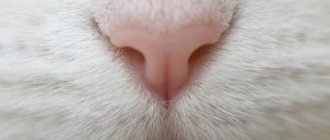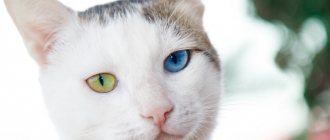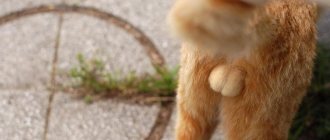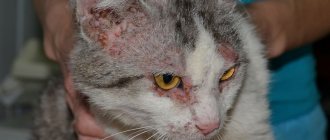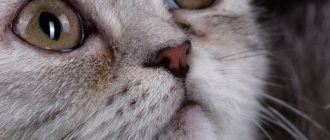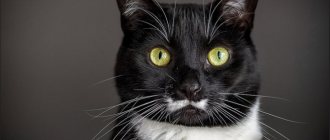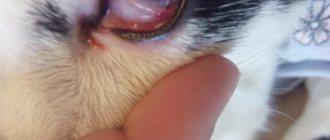For cats, the nose is a significant tool in exploring the world around them. An excellent sense of smell helps cats navigate space through smells, warm and clean the air from small debris, dust particles and microbes.
Unfortunately, a cat cannot always attract the attention of its owner to the problem that worries it: the ancient instinct of a predator does not allow animals to show their weakness. For this reason, cats' noses have become susceptible to many myths about animal health, but at the same time can signal possible problems. In this article, we figured out what a healthy cat’s nose should be like and for what reasons it can be hot. You will also learn which symptoms require urgent attention, how to diagnose and what to do next.
What should a healthy cat's nose look like?
From the very first days of its life, a blind and deaf kitten relies only on its sense of smell: with its help, it finds its littermates, and its sense of smell helps to find the milky smell of its mother’s nipples. Throughout its life, the animal studies space through the nose, which means this organ, being one of the most active, can say a lot about the pet’s health.
Let's look at the structure of the cat's nose: it consists of two nasal entrances, separated by a cartilaginous septum, behind them begin the “ethmoid conchae” - a complex structure that allows cats to retain a certain smell in the corners of the shell and separate it from impurities for more accurate identification.
Structure of a cat's nose
Having passed through this complex structure, the odor molecules irritate the sensitive cells in the olfactory center of the nose, which helps the cat recognize the aroma and remember it.
IMPORTANT: a cat’s nose is 15 times more sensitive than a human’s and has about 80,000,000 receptors.
Smells that are familiar to humans can be very pungent for a cat: the smell of perfumes, spices, and citrus fruits will cause sneezing, and the animal will begin to rub and hide its nose.
Most often, animal owners observe the nose - a soft “button” on the animal’s face that everyone tries to touch. It is no coincidence that the nose is called a “mirror”: throughout your pet’s life, you can note what the cat “sees” with this organ.
Healthy nose
IMPORTANT: in a healthy state, the cat’s nose is slightly wet, not hotter than the animal’s body temperature. There are no pathogenic inclusions in the form of wounds, crusts, or obvious cloudy discharge.
Why does a cat's nose sometimes become a little wetter? The fact is that the nose secretes a special lubricant, the moisture of which protects the nasal passages from drying out. In addition, cats often deliberately lick their already wet nose.
In addition to its direct olfactory function, a cat’s nose warms and purifies the air it inhales; the skin of the nose is very sensitive and helps the animal determine the temperature of food, objects and surfaces without touching.
The color of the “mirror” of the nose matches the color of the fur on the muzzle; pigment spots may be present on it; the nose of an adult cat can also turn black with age. The black coloration of the nose makes it more difficult to identify a potential health problem; in this case, you can examine the mucous membranes of the mouth and eyelids. A light, almost white nose in cats most clearly demonstrates a possible illness, since blood vessels are clearly visible through it.
Black nose
Light, almost white nose
Pigmentation on the nose
The opposite problem is that the nose is too wet.
Although wetness is the recommended condition for a cat's nose, in some situations it can indicate pathology. Such exceptions include:
- Cold
. Due to a runny nose and frequent sneezing, the earlobe does not have time to dry out.
- Allergy
. The number of discharges correlates with colds. The only difference is that the symptoms disappear soon after the allergen is eliminated.
- Tumors, polyps and foreign objects
. Trying to get rid of the obstacle, the body produces an increased amount of mucus. If internal damage occurs, the discharge may contain blood or pus.
- Hypothermia or poisoning
. In addition to mucosal sputum, a decrease in temperature is noted.
- Infections
. Hot ears and copious discharge from the sinuses are characteristic of rhinotracheitis and panleukopenia.
- Cardiovascular diseases
. The appearance of increased humidity is accompanied by blanching of the mucous membrane.
This variety of possible interpretations confirms the danger of self-medication. An incorrect diagnosis can lead to aggravation of the real problem and deterioration of the animal's condition.
Should I worry?
If you are convinced that everything is in order with the cat’s health, the animal’s nose does not need additional care. Health problems are excluded by clinical diagnosis in a veterinary clinic, regular care of the animal, good nutrition and routine vaccination, deworming, cleaning from fleas and other parasites.
IMPORTANT: if you find a warm, dry nose on a cat, leave the animal for a while and touch the nose again. If you find other alarming symptoms, consult a specialist!
Diagnostics
Only a doctor can diagnose the presence of infection based on the results of a staphylococcus test.
It is worth remembering that testing is recommended only if symptoms of the disease are present. The presence of bacteria in biological material may mean that a person is its carrier, which in itself is the norm.
For analysis, material is taken from the area where the infection is believed to be developing. To detect a pathological process, several tests are carried out to track the dynamics of bacterial growth. If their number increases rapidly, the presence of a staphylococcal infection can be diagnosed. Also, additional analysis will determine the specific type of infection so that the doctor can choose a personal treatment regimen.
Features of the animal's condition
In a normal state, the animal’s lifestyle does not change. Minor changes in the appearance of the nose can be caused by external factors and resolve on their own. In this case, the animal helps itself: it washes itself, licks and moisturizes its nose. The pet remains active, eats well, plays a lot and shows affection to its owner.
In the presence of pathology, the animal’s behavior changes
IMPORTANT: make sure that the animal always has fresh and clean water, and that the room maintains a comfortable temperature.
Kitten has a hot nose
A hot nose in kittens is most often a sign of their playfulness and increased activity. They run a lot, play, are very curious and try to quickly explore the world around them. A warm and dry nose in this case is not a cause for concern.
Increased activity can cause temporary dry nose in a kitten.
But if you notice that the kitten’s nose remains dry throughout the day, or purulent discharge appears, contact a specialist. Such signs may indicate the occurrence of rhinitis, as well as neoplasms in the nasal passages and sinuses.
Show increased attention to your baby: at an early age, foreign bodies may enter the nasal cavity.
Symptoms and forms of staphylococcus in adults and children
The symptoms experienced by the patient vary greatly depending on the method and location of infection and the state of the immune system. But a number of the most characteristic features can be identified:
● elevated temperature;
● suppuration of cuts, swelling, purulent rashes on the skin and mucous membranes, itching and redness of the eyes;
● lack of sense of smell and nasal breathing;
● sore throat, pain when swallowing, dry cough;
● nausea, vomiting, general weakened state;
● severe headaches, epileptic attacks, severe shortness of breath;
● painful sensations in the joints.
One of the most common forms of staphylococcus in adults is its asymptomatic carriage. A healthy person does not feel any signs of the disease until a provoking factor appears that gives impetus to the development of the disease.
For women, the most dangerous form is the saprophytic form, which can lead to cystitis. This is due to the fact that the women’s urethra is located very close to the vagina, which is why there is a high probability of pathogenic microflora, including staphylococcus bacilli, entering the urethral canal, and then into the bladder, causing its inflammation.
Since young children do not have a strong immune system, the risk of developing an infection in a child is quite high. Moreover, even those types of staphylococcus that cause practically no problems in adults can lead to serious complications in children. Staphylococcus is especially dangerous in children under one year of age, as it can easily spread throughout the body in the shortest possible time and lead to serious consequences, including death.
How to examine an animal yourself?
First, pay attention to the color of your nose and oral mucosa. Touch the paws and inspect them for redness.
IMPORTANT: if the nose is black, inspect the eyelids and the surface of the mucous membrane in the animal’s mouth.
This is what anemia looks like on the oral mucosa
– pallor of the mucous membrane occurs with hypothermia, the development of anemia, the initial stage of poisoning;
– yellow color of the mucous membrane indicates liver disease;
– bluish color of the mucous membrane may indicate a malfunction of the heart;
– redness is characterized by infections, inflammations, allergies, increased temperature and pressure.
Next, using a stopwatch, you can measure the cat's pulse from the inside of the thigh. Feel the pulsation and count the tremors for 15 seconds. Multiply the sum of calculations by 6, so you will determine the number of beats per minute.
An example of how to measure a cat's pulse at home
IMPORTANT: the animal’s normal pulse is no more than 140 beats per minute. The animal's pulse may change during the mating season.
What is the danger
- If the mucous membranes of the throat or nose are affected, there is a high probability of swelling. It spreads quickly and makes breathing difficult. Up to the point of suffocation.
- When ingested or inhaled vapors of acids and alkalis, damage to the nasopharynx and throat is usually combined with deeper damage to the trachea, esophagus and other internal organs. Necrosis of esophageal tissue and perforation are possible.
- External burns cause intoxication and take a long time to heal without proper treatment. The wound surface becomes infected.
- If the lesions are strong and extensive, a painful shock occurs.
How to take your pet's temperature
Enlist the help of a person to whom the animal is friendly - this will make it easier to measure the cat’s body temperature. Be gentle, do not make sudden movements, lull and stroke the animal.
An electric thermometer will give the most accurate readings
IMPORTANT: the cat must have its own individual electric thermometer. Body temperature is measured through the anus of the animal and should not exceed the limit of 38-39 degrees.
Take a thermometer, disinfect it, treat it with Vaseline to soften the passage. Place the cat on a hard surface, you can calmly grab the animal with your hands and fix it. Carefully place the thermometer 2 cm into the anus. Calm and stroke the cat, hold the thermometer for the right time (the electric thermometer will notify you yourself).After manipulations, re-disinfect the thermometer and place it in the first aid kit.
Symptoms that require doctor's attention
Use caution and seek medical attention if you notice any serious changes in your cat's behavior:
– the animal has become lethargic, apathetic, refuses to eat;
– sleeps a lot, does not respond to calls to play, is indifferent to favorite treats and entertainment;
– the cat’s stool becomes more frequent or worse, and vomiting appears;
– increased salivation is observed;
– green nasal discharge and sneezing appeared;
– the animal reacts negatively to an attempt to touch it;
– body temperature is increased, paws and ears turn red and become very hot;
The presence of such symptoms is a reason to immediately visit a veterinary clinic.
Cases of non-dangerous deviations from the norm
- When Murka sleeps. After all, at this time she does not lick her muzzle, and the glandular cells hardly produce phlegm. The nose can remain dry and warm for another half hour or hour after sleep.
- Kittens, like... little guys, have unstable thermoregulation, so their body temperature is often elevated. For example, after sleep, games, meals, and even depends on the mood. It happens that the mother does not lick the baby thoroughly. Then the owner himself will have to wash it several times a day with a napkin with warm and boiled water.
- In winter, radiators in our homes both heat and reduce air humidity.
- Mild and short-term illness of the pet (overeating, excess hair getting into the stomach, etc.), stress or fear, pregnancy, childbirth, etc.
- Active and moving activities when the body warms up.
- Hot and muggy environment. But, after the end of unfavorable conditions, everything also returns to normal for the cat.
- The advanced age of the animal, during which metabolism slows down, and therefore... the nose is almost always dry and warm.
- So, for all these reasons (except for No. 7), the animal’s olfactory organ does not remain dry and warm for long. And if for a long time and, especially, other symptoms of trouble in the body are present, this sign portends serious illnesses. Which?
What measures should be taken
Only a doctor can diagnose the presence of a dangerous pathology in combination with external signs.
IMPORTANT: if you notice an illness, you can measure the animal’s pulse and temperature - this is the permissible maximum of measures that you can take at home before the veterinarian arrives. Diagnostics and other medical procedures are carried out only by a specialist!
You can help your animal by eliminating external factors that can cause changes in the nose:
- Regulate the heating temperature of the room, and thoroughly dry the animal’s fur after water treatments. Make sure that the cat is in a warm and comfortable environment, this way you will prevent your pet from becoming hypothermic.
- If your pet spends time outside in hot weather, constantly replenish the supply of clean and fresh water, make sure that the cat has access to a cool place. The animal will feel dehydration and will help its body on its own.
IMPORTANT: with a sunburn, the skin on the nose turns red and becomes hot and painful. In this case, Panthenol gel will help you; you should apply it carefully, avoiding getting into the nostrils. Make sure that the animal does not have other alarming symptoms.
A red and sore nose may be a sign of sunburn
- Humidify the indoor air and regularly ventilate the room in which your pet is located.
- Protect your cat from any factors that cause fear or stress in the animal.
- After consulting a veterinarian, you can learn how to clear your pet’s nose of snot and dirt on your own - this way you will make your animal’s life easier. Nasal rinses are purchased at a veterinary pharmacy, and the first rinse is carried out under the supervision of a veterinarian.
- The position of a cat before giving birth requires special attention: the animal is susceptible to stress, pain and emotional outbursts. Monitor the cat's condition, provide care and, if necessary, call a doctor at home.
Treatment
Even an experienced breeder will not be able to diagnose a dangerous disease just because the cat’s nose has become hot and dry. It is easy to make a mistake in diagnosis even based on a combination of external signs.
The main thing that the owner of a sick animal should do before contacting a veterinarian is to measure the temperature of his pet. At home, its indicator will be more accurate than in the clinic, where the cat usually experiences additional stress, aggravating the patient’s condition.
What you can handle on your own
If nothing serious has happened, the owner can bring things back to normal himself - there are a lot of similar situations, we will describe only the most common ones.
Nasal contamination
If you forget to regularly clean your pet's nose, heavy contamination will make it difficult for him to breathe and interfere with the production of physiological lubrication. As a result, thermoregulation will be disrupted and the nose will become hot. A dirty nose must be carefully cleaned both outside and inside so as not to damage sensitive tissues. After 15–20 minutes, all parameters of his condition are normalized.
Clean your cat's nose thoroughly and it will immediately feel better.
Sunburn
All cats love warmth and can happily doze off “in the sun.” But a long stay under the scorching rays of the sun will definitely not do them any good. Incidents of burns are more common than one might think, especially in animals with delicate pink noses.
A cat who has received a sunburn will have a red, hot, and sore nose. After some time, the skin on it will become rough, rough and dry. Immediately use anti-burn, moisturizing and anti-inflammatory agents - for example, Panthenol. Apply the medicine carefully so that it does not get into the nostrils, and repeat the procedure more often as the product is absorbed.
Cats with pink noses are more likely to get burned than others.
Allergy to chemicals
Many animals, like people, are prone to allergies. Remember this when cleaning your apartment - poorly washed cleansers can cause considerable harm to your inquisitive cat, who literally pokes his nose into every corner of the house.
You are cleaning with gloves, and perhaps even a respirator, but the cat’s nose is not protected by anything... Aggressive chemicals entering the respiratory system can cause severe allergies in the animal, and the nose will be the first to react: its temperature will increase, discharge or rashes will appear.
Chemicals can cause allergies in cats
It is urgent to carry out repeated wet cleaning, wash off with clean water all the remaining chemicals that provoke irritation and allergic reactions. At the same time, consult your veterinarian about which antihistamines and in what dosage should be given to your cat.
In what cases is the help of a veterinarian required?
Do not self-medicate and do not waste time; at the slightest suspicion that the animal is sick, contact a veterinary clinic. Only a doctor can conduct all the necessary studies to clarify the picture of the disease, make an accurate diagnosis and prescribe effective treatment.
A signal for an urgent visit to the veterinarian can be either the fact that the cat’s nose remains hot and dry for more than half an hour for no apparent reason, or additional alarming symptoms that were described above. Timely seeking medical help can save your pet's life - for example, in case of poisoning.
The most common condition that causes a cat's nose to become hot is rhinotracheitis, a viral infection of the upper respiratory tract. An infected cat is in a depressed state, and its nose soon becomes wet from being dry, discharge appears from it, from the eyes, from the mouth... the nose turns red, becomes covered with wounds and crusts. It is difficult for a cat to breathe and eat; the digestive and nervous systems suffer. If this disease is left untreated or treated incorrectly, the cat can suffer serious complications and even die.
Video: what to do if your cat has a cold
Advice for caring owners
When communicating with our beloved pet, we don’t need words: we feel their love and affection, observe how playfully and carefree they show their habits, and admire their grace. As creatures of the wild, domestic cats live and experience this world through their baser instincts.
A happy pet creates the world around him through the care of his owner
You can get much closer and learn to understand your pet's signals and behavior by learning basic information about the structure of their amazing organisms. Regular care and attention to your pet will make you a rare guest in the veterinarian's office.
Causes
Most often, the bacterium enters the human body through wounds and microcracks in the skin. The infection, having penetrated through the wound, begins to multiply in the blood, spreading throughout the body and affecting the lungs, heart, brain, liver, kidneys, and joints.
With staphylococcus, diseases can be very different, such as pneumonia, meningitis, osteomyelitis, endocarditis, sepsis and many others.
Staphylococcus infection can occur in the following ways:
● Through contact and household use when using the patient’s personal items;
● Airborne droplets during close contact with an infected person;
● Fecal-oral on dirty fruits, vegetables and other food products, dirty dishes and hands;
● Vertical when a child passes through the birth canal of an infected mother during childbirth.
● Infection often occurs during surgery through medical instruments and during various manipulations.

